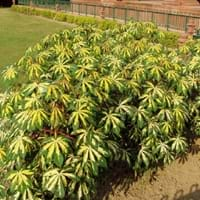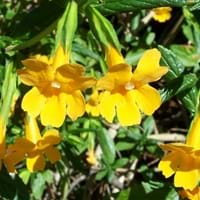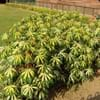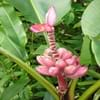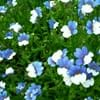Life Span
Perennial
Perennial
Type
Tender Perennial
Flowering Plants, Tender Perennial
Origin
South America, Brazil
Hybrid origin
Types
Not Available
Not Available
Habitat
Canyons, gardens, Grassland, Rainforest, Shaded sites
Dry areas, Rocky areas, Sandy areas, Wet lands
USDA Hardiness Zone
8-13
9-10
AHS Heat Zone
Not Available
Not Available
Sunset Zone
H2, 19, 20, 21, 22, 23, 24
A1, A2, A3, H1, H2, 1a, 1b, 2a, 2b, 3a, 3b, 4, 5, 6, 7, 8, 9, 10, 11, 12, 13, 14, 15, 16, 17, 18, 19, 20, 21, 22, 23, 24
Habit
Upright/Erect
Cushion/Mound-forming
Minimum Width
Not Available
Flower Color
White, Red
White, Yellow, Red, Orange, Pink, Rose
Flower Color Modifier
Bicolor
Bicolor
Fruit Color
Brown
Not Available
Leaf Color in Spring
Green, Light Yellow, Ivory
Green
Leaf Color in Summer
Dark Green, Light Yellow, Ivory
Green
Leaf Color in Fall
Dark Green, Light Yellow, Ivory
Green
Leaf Color in Winter
Light Green
Light Green
Leaf Shape
Palmate
Linear
Plant Season
Spring, Summer, Fall, Winter
Summer
Sunlight
Full Sun, Partial Sun
Full Sun, Partial Sun
Type of Soil
Loam, Sand
Loam, Sand
The pH of Soil
Acidic, Neutral
Acidic, Neutral
Soil Drainage
Average
Well drained
Bloom Time
Late Spring, Summer, Fall
Early Summer, Summer, Late Summer
Tolerances
Drought
Drought
Where to Plant?
Ground
Ground
How to Plant?
Stem Planting
Seedlings
Plant Maintenance
Medium
Medium
Watering Requirements
Keep the ground moist but not water-logged, Prefer drip-irrigation instead of Over-head watering, Reduce watering in winter, Requires watering in the growing season
Average Water Needs
In Summer
Lots of watering
Lots of watering
In Spring
Moderate
Moderate
In Winter
Average Water
Average Water
Soil pH
Acidic, Neutral
Acidic, Neutral
Soil Type
Loam, Sand
Loam, Sand
Soil Drainage Capacity
Average
Well drained
Sun Exposure
Full Sun, Partial Sun
Full Sun, Partial Sun
Pruning
Prune if you want to improve plant shape, Remove damaged leaves, Remove dead leaves, Remove deadheads, Shape and thin as needed
Remove damaged leaves, Remove dead branches, Remove dead leaves
Fertilizers
All-Purpose Liquid Fertilizer, Fertilize before watering, fertilize every 2-3 weeks while growing
All-Purpose Liquid Fertilizer
Pests and Diseases
Mites, Red blotch, Scale, Thripes, Whiteflies
Larva
Plant Tolerance
Drought
Drought
Flowers
Insignificant
Showy
Flower Petal Number
Single
Single
Foliage Texture
Coarse
Medium
Foliage Sheen
Glossy
Matte
Attracts
Birds
Bees, Butterflies, Hummingbirds
Allergy
Not Available
no allergic reactions
Aesthetic Uses
Not Used For Aesthetic Purpose
Beautification, Showy Purposes
Beauty Benefits
Not Available
Not Available
Environmental Uses
Air purification
Air purification
Medicinal Uses
Cancer
Antiseptic, Burns
Part of Plant Used
Whole plant
Flowers, Root
Other Uses
Animal Feed, Culinary use, Used as Biofuel, Used in making beverages
Not Available
Used As Indoor Plant
No
No
Used As Outdoor Plant
Yes
Yes
Garden Design
Feature Plant, Herb / Vegetable, Mixed Border, Tropical
Bedding Plant, Container, Hanging Basket, Mixed Border
Botanical Name
MANIHOT esculenta 'Variegata'
Diplacus aurantiacus
Common Name
Variegated Cassava, Variegated Tapioca
Magic Mix Monkey-flower, Monkey-flower
In Hindi
Variegated Cassava
Monkey Flower
In German
Verändertes Cassava
Monkey Flower
In French
panaché manioc
Monkey Flower
In Spanish
abigarrado Yuca
Monkey Flower
In Greek
Κυμαίνεται Cassava
Monkey Flower
In Portuguese
variegated de mandioca
Monkey Flower
In Polish
Kolorowy Maniok
Monkey Flower
In Latin
variegated Cassava
Monkey Flower
Phylum
Not Available
Tracheophyta
Class
Not Available
Magnoliopsida
Order
Malpighiales
Lamiales
Family
Euphorbiaceae
Scrophulariaceae
Clade
Angiosperms, Eudicots, Rosids
Angiosperms, Asterids, Eudicots
Tribe
Manihoteae
Not Available
Subfamily
Crotonoideae
Not Available
Number of Species
Not Available
Season and Care of Variegated Cassava and Monkey-flower
Season and care of Variegated Cassava and Monkey-flower is important to know. While considering everything about Variegated Cassava and Monkey-flower Care, growing season is an essential factor. Variegated Cassava season is Spring, Summer, Fall and Winter and Monkey-flower season is Spring, Summer, Fall and Winter. The type of soil for Variegated Cassava is Loam, Sand and for Monkey-flower is Loam, Sand while the PH of soil for Variegated Cassava is Acidic, Neutral and for Monkey-flower is Acidic, Neutral.
Variegated Cassava and Monkey-flower Physical Information
Variegated Cassava and Monkey-flower physical information is very important for comparison. Variegated Cassava height is 240.00 cm and width 180.00 cm whereas Monkey-flower height is 12.70 cm and width Not Available. The color specification of Variegated Cassava and Monkey-flower are as follows:
Variegated Cassava flower color: White and Red
Variegated Cassava leaf color: Green, Light Yellow and Ivory
Monkey-flower flower color: White, Yellow, Red, Orange, Pink and Rose
- Monkey-flower leaf color: Green
Care of Variegated Cassava and Monkey-flower
Care of Variegated Cassava and Monkey-flower include pruning, fertilizers, watering etc. Variegated Cassava pruning is done Prune if you want to improve plant shape, Remove damaged leaves, Remove dead leaves, Remove deadheads and Shape and thin as needed and Monkey-flower pruning is done Remove damaged leaves, Remove dead branches and Remove dead leaves. In summer Variegated Cassava needs Lots of watering and in winter, it needs Average Water. Whereas, in summer Monkey-flower needs Lots of watering and in winter, it needs Average Water.
